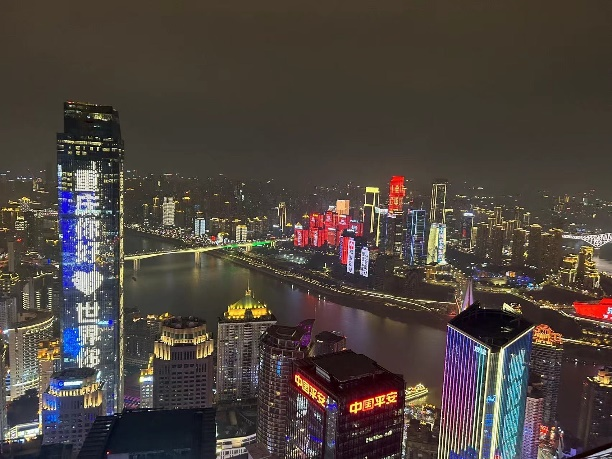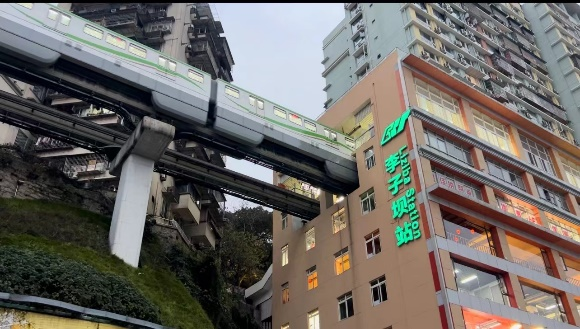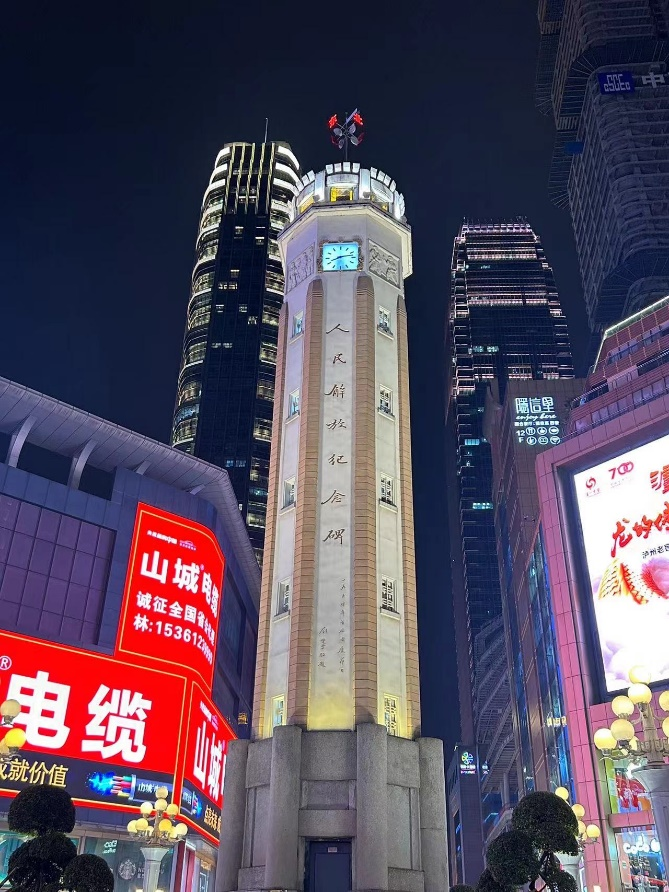
重慶夜景
Night Scenery of Chongqing
一.渝城記憶——現代
走進重慶是一場從三維世界到八維世界的跨越縱橫交錯的盤龍立交穿樓而過的李子壩輕軌橫跨樓間的空中連廊重慶,生活在高低錯落的空間裏。當你感覺站在一樓時其實你在八樓。三千年的巴渝八百載重慶。這裡,同時存在著過去和未來。
Entering Chongqing is a crossing from a three-dimensional world to an eight dimensional world, crisscrossing the Panlong overpass and passing through the buildings. The Liziba Light Rail spans the aerial corridor between the buildings in Chongqing, living in a space of staggered heights. When you feel like you’re standing on the first floor, you’re actually on the eighth floor. Three thousand years of Ba Yu and eight hundred years of Chongqing. Here, there exists both the past and the future
二.渝城記憶——歷史
在抗日戰爭時期,洪崖洞成為了重慶市民的避難所,很多人在這裡為了躲避戰爭。
1941年12月13日,日軍轟炸重慶時,一枚炸彈落在了洪崖洞附近的山坡上,引發了山火。火勢迅速蔓延到了洪崖洞內部,造成了巨大的損失。當時,在洪崖洞內有一家名叫“金龍飯店”的餐館,老闆是一個叫郭選昌的人。他為了保護自己的店舖和顧客,不顧自身安危,在火海中奮力滅火,並且帶領店員和顧客逃出了生天。他被譽為“重慶之火中英雄”,並且被雕塑家劉開渠用青銅雕塑了下來,成為了洪崖洞的一道風景。
During the Anti Japanese War, Hongya Cave became a refuge for Chongqing citizens, and many people stayed here to avoid the war.
On December 13, 1941, during the Japanese bombing of Chongqing, a bomb landed on the hillside near Hongya Cave, triggering a wildfire. The fire quickly spread to the interior of Hongya Cave, causing huge damage. At that time, there was a restaurant called”Golden Dragon Restaurant” in Hongya Cave, owned by a person named Guo Xuanchang. In order to protect his store and customers, he disregarded his own safety and fought hard to extinguish the fire, leading the staff and customers to escape from the flames. He is known as the”hero of Chongqing’s fire” and was sculpted in bronze by sculptor Liu Kaiqu, becoming a scenic spot in Hongya Cave.
重慶人民解放紀念碑的故事要從1937年説起,這一年重慶作為陪都遭受了日本長達五年半的大轟炸,街道和房屋都被炸成了一片廢墟,在這片廢墟中炸出了一個深坑。為了鼓舞士氣,激發全國人民的抗日鬥爭精神,1940年3月12日孫中山先生逝世的日子,在這個深坑上面建了一座精神堡壘。這座精神堡壘是木質結構,高七丈七尺,象徵著七七抗戰,為了防止被轟炸,還將它的外表涂成了黑色。儘管如此,它還是經歷了多次轟炸和修復,斷斷續續修了一年多,直到1941年的12月30日才完工。
然而,這座用木頭製作的精神堡壘終究經不起風吹日曬,不到兩年就倒塌了,於是重慶人民在這個原址上面豎了一根旗桿來代替。到了1945年抗戰勝利之後,為了紀念中華民族和重慶人民為抗戰勝利做出的犧牲和貢獻,在這個精神堡壘的舊址上建立了抗戰勝利記功碑。
1949年11月30日,重慶解放之後,這座碑第三次改名變成了現在所看到的人民解放紀念碑。它不僅是紀念重慶和西南的解放,更是紀念全中國人民的解放。
The story of the Chongqing People’s Liberation Monument can be traced back to 1937, when Chongqing, as a capital, suffered from a five and a half year long Japanese bombing. The streets and houses were destroyed, and a deep pit was blasted out of the ruins. In order to boost morale and inspire the anti Japanese spirit of the entire nation, a spiritual fortress was built on the day of the death of Sun Yat sen on March 12, 1940, in this deep pit. This spiritual fortress is a wooden structure, standing seven zhang and seven feet high, symbolizing the Anti Japanese War of 77. In order to prevent bombing, its exterior was painted black. Nevertheless, it underwent multiple bombings and repairs, and was repaired intermittently for over a year until it was completed on December 30, 1941.
However, this spiritual fortress made of wood could not withstand the wind and sun, and collapsed in less than two years. Therefore, the people of Chongqing erected a flagpole on this original site to replace it. After the victory of the Anti Japanese War in 1945, in order to commemorate the sacrifices and contributions made by the Chinese nation and the people of Chongqing to the victory of the War, a monument was erected on the site of this spiritual fortress to commemorate the victory of the Anti Japanese War.
On November 30, 1949, after the liberation of Chongqing, this monument was renamed for the third time as the People’s Liberation Monument as seen today. It is not only commemorating the liberation of Chongqing and Southwest, but also commemorating the liberation of the entire Chinese people.

重慶李子壩
Liziba, Chongqing

重慶洪崖洞
Hongya Cave in Chongqing

重慶人民解放碑
Monument to the people’s Liberation of Chongqing People